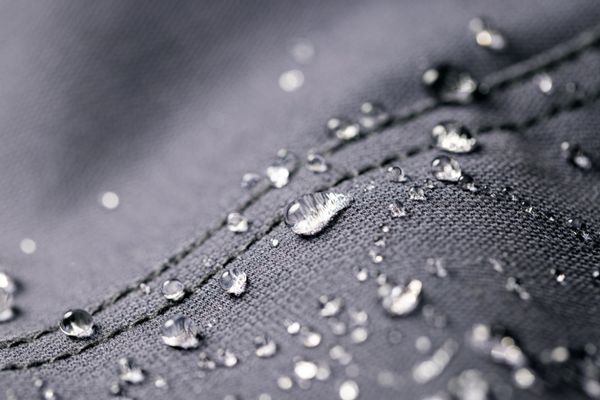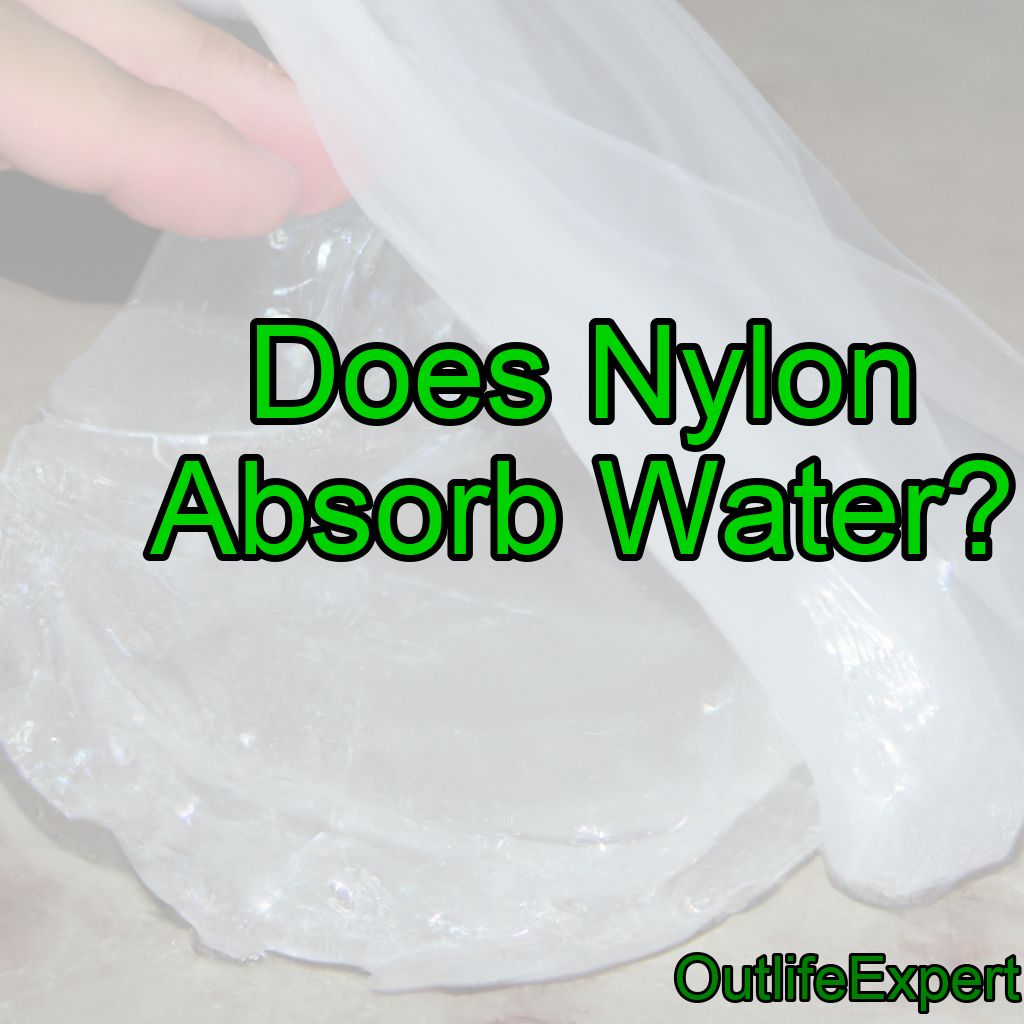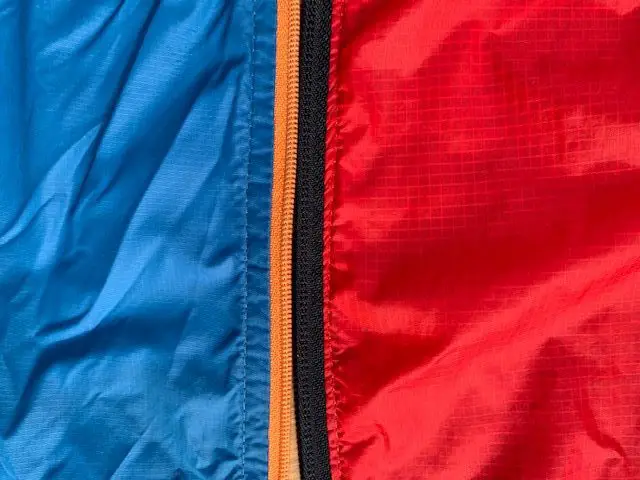Have you ever wondered if nylon absorbs water? If so, you’re not alone! Many outdoor adventurers want to know the answer to this important question.
Yes, nylon does absorb water. It is a hygroscopic material, meaning it can attract and hold water molecules from the surrounding environment. However, the amount of water absorbed depends on factors such as humidity, temperature, and the specific type of nylon. To minimize water absorption, consider using a water-resistant coating or selecting a different material with lower water absorption properties.
The amount of water nylon can absorb varies depending on the specific type of nylon and the conditions under which it is exposed to water.
Nylon 6 can absorb up to 10% or more by weight, while other types of nylon will absorb much less water.
Moisture absorption can cause changes in dimensional stability, physical properties, and glass transition temperature of nylon, and drying times can range from 3-4 hours to 24 hours or more depending on the extent of moisture penetration.
Let’s take a closer look at this intriguing issue together and find out all we need to know about nylon and its ability to absorb water.
How much water can nylon absorb?
I will start out by saying that the amount of water nylon can absorb depends on the specific type of nylon and the conditions under which it is exposed to water.
For example, nylon 6 can absorb a significant amount of water, up to 10% or more by weight, when immersed in water or exposed to high humidity.

In contrast, other types of nylon, such as Intech Power-Core™ PA12GC (Nylon 12), absorbs much less water, up to a maximum of 1.4% by weight when fully submerged in water, which makes it stronger in wet conditions.
The rate and content of moisture absorption in nylons are lower when compared to nylon 6 because of the addition of extra hydrocarbon segments into the repeating unit structure.
For instance, Nylon 12 saturated at 1.4% while Nylon 6 saturated at 9.4%. Intech Power-Core™ PA12GC, when fully submerged in water, absorbs a maximum of 1.4%, while nylon 6 has an absorption rate of over 10%.
The effects of moisture absorption on nylon can include changes in dimensional stability, physical properties, and transition temperature from rigid to soft nylon fibers.
For instance, nylon that absorb moisture can experience changes in size by up to 0.05% at room temperature, while the modulus of elasticity can decrease as the amount of absorbed water increases.
To remove moisture that has been absorbed onto the surface of nylon, drying for 3-4 hours may be sufficient.
However, for moisture that has penetrated deeper into the material, a much longer drying time of up to 24 hours or more may be required.
It is also worth noting that nylon is a hygroscopic material, which means that it absorbs liquids rather than resisting them.
As such, nylon is not waterproof in its most basic form, and its ability to absorb water can be influenced by factors such as temperature and humidity.
How Nylon Interacts With Water
Nylon is a strong, durable material that can be used for various purposes. It has good sorption capacity and offers excellent resistance to wear and tear.

However, it’s important to understand how nylon interacts with water.
1. Water may affect the durability of nylon when exposed over time. This could lead to reduced waterproofing capabilities or color fading in some cases.
2. When washing items made from nylon, make sure you follow specific instructions on the label so as not to damage the fabric by using incorrect cleaning methods.
3. If you’re looking for extra protection against water exposure, there are special waterproofing methods available which will help protect your garments without affecting their quality and performance.
The nature of water absorption by nylon is complex due to its unique properties such as hydrophobic characteristics and moisture management capability; however, understanding these factors will enable us to take better care of our clothing and accessories made from this versatile material.
Nylon loses its strength when wet!
Nylon is a popular engineering thermoplastic known for its high strength and toughness. However, the tensile strength of nylon is highly dependent on its moisture content. When exposed to moisture, nylon behaves as a plasticizer, which reduces its strength and stiffness properties but increases its elongation and toughness.
The amount of tensile strength loss in nylon due to moisture absorption varies depending on the type of nylon. For example, the tensile strength of nylon 6 drops by over 80% from dry to saturated state, while for nylon 6.6, the drop is over 60%.
The graph below shows the effect of moisture on the tensile strength of nylon 6.6, 6 and 12:

It’s worth noting that not all nylon types behave the same way when exposed to moisture. For instance, the tensile strength of dry nylon 6 at 20 °C is typically 76-97 MN m-2, and its properties are highly dependent on water content. On the other hand, the physical Properties Of Nylon include high tensile strength, high-temperature resistance, and more friction resistance than standard, non-engineering plastics. The breaking extension of nylon is 20 to 40%, and its stiffness ranges between 20-40 gm/density.
Therefore, it’s important to consider the moisture content of nylon when designing and using it in applications. For instance, nylon moldings with high moisture content will have reduced strength and stiffness but increased elongation and toughness.
Also, it’s worth noting that the moisture content of nylon resins can vary depending on the manufacturing process and storage conditions.
In summary, the hydration level of nylon significantly affects its tensile strength. The higher the moisture content, the lower the tensile strength. It’s important to keep this in mind when designing and using nylon in applications where high strength is critical.
Effect Of Temperature On Nylons Water Absorption
The amount of moisture that nylon can absorb is influenced by several factors, including temperature, relative humidity, exposure time, the type of nylon, and the thickness of the part. At room temperature, in a 50% relative humidity environment, the equilibrium moisture content for nylon tends to remain around 2%.
This corresponds to an increase in size of roughly 0.5 – 0.6%. Under similar conditions, acetal is expected to absorb roughly 0.2% moisture by weight and grow around 0.2%. The amount of moisture absorbed by nylon depends on the temperature and relative humidity of the surrounding environment.
It is worth noting that nylons are hygroscopic, meaning that they absorb moisture from the surrounding air or water if submerged.
The higher the humidity, the faster nylon absorbs moisture. Immersing nylon in water will cause it to absorb moisture extremely fast. However, it only absorbs moisture until it reaches saturation.
Temperature also affects the hydration capacity of nylon. An unfilled Nylon 6 part can change in size by 0.05% at room temperature, but this can increase with temperature. Temperature increases will allow more water to be absorbed into the part.
In terms of physical properties, nylons have a stronger tensile strength, high-temperature resistance, and more friction resistance than more standard, non-engineering plastics.
The breaking extension is 20 to 40%, and the stiffness ranges from 20-40 gm/density. Adding fiber can increase the tensile strength of nylon by about twice, and the temperature resistance can be improved accordingly.
Potential Effects Of Water Absorption On Nylon
Nylon’s ability to absorb water can have a variety of effects on the fabric.
When woven with certain techniques, nylon may be able to hold more water and become heavier, making it less durable compared to other fabrics.
On the flip side, its absorptive properties make nylon easier to clean than some other materials.
If cared for properly, this material can retain its softness even after being washed multiple times.
To prevent shrinkage due to moisture absorption while washing or drying, select low heat settings when laundering items made from nylon fabrics.
When considering how best to care for an item made from nylon fabric, take into account that repeated exposure to water can break down the fibers over time.
In addition to following cleaning instructions provided by the manufacturer, use gentle detergents specifically formulated for delicate fabrics in order to extend their life span.
Lastly, don’t forget that air-drying is always preferable as opposed to machine drying whenever possible – especially if you want your garments or accessories made from nylon fabrics looking new longer!
Frequently Asked Questions
What Is The Best Way To Clean Nylon Fabric?
When it comes to cleaning nylon fabric, there are a few tips and tricks that an outdoor expert recommends for keeping your gear in tip-top shape.
From washing techniques to care instructions and stain removal methods, brushing up on the basics can help you make sure your clothing is ready for anything nature throws its way!
Whether you’re looking for waterproofing methods or drying techniques, knowing how best to clean nylon fabric will ensure all of your adventures remain enjoyable ones.
Is Nylon A Durable Material?
Nylon is one of the most durable materials around, with excellent resistance to wear and impressive abrasion resistance.
It also has a great breathability factor, and its water and stain repellence make it ideal for outdoor activities that require some protection from the elements.
Perfect for those who crave freedom in their adventures!
How Does The Color Of Nylon Affect Its Water Absorption?
When it comes to the color of nylon and its impact on water absorption, outdoor experts have speculated that lighter colors are more likely to absorb moisture than darker shades.
This begs the question: does the lightweight properties, stain resistance, waterproofing capabilities, UV protection and odor control of nylon make any difference?
To answer this question we must investigate further. Studies suggest that one of the most important factors in determining how well a fabric will resist absorbing water is not just its color but also the type of finish applied – with hydrophobic finishes being among the best at repelling liquid.
Therefore while the color may play some part in how well your material resists water absorption, there are other considerations worth keeping in mind if you desire maximum waterproofing capabilities.
Does Nylon Shrink When Wet?
Storing nylon and washing techniques can affect how much water a garment with this material absorbs.
Water-resistant nylon is more likely to repel liquid than absorb it, but colorfastness and breathability should still be taken into account when selecting the right fabric for an outdoor activity.
For example, if you’re looking for something lightweight that won’t shrink when wet, then going with a waterproof option will ensure your comfort even in inclement weather.
Ultimately, there are many factors to consider when choosing the best nylon clothing for your needs.
Does Nylon Fade When Exposed To Water?
When it comes to the great outdoors, nylon can be a tricky fabric to keep looking new.
While waterproofing and breathability of nylon fabrics are important for mildew prevention and treating stains, many people wonder if this dependable material will fade when exposed to water.
The answer is yes – while nylon doesn’t shrink in wet conditions, its colors may start to run or look washed out after extended exposure to moisture.
To avoid fading, dry your nylon items right away and use protective sprays designed specifically for synthetic fibers.
With proper care and maintenance, you’ll have reliable apparel that keeps up with your active lifestyle!
Conclusion
As an outdoor expert, I can confidently say that nylon is a great material for cleaning and it will last you a long time.
Nylon has good water absorption properties; however, the color of the fabric does matter when it comes to how much moisture the fiber absorbs.
The rate and content of moisture absorption in nylons are lower when compared to nylon 6 because of the addition of extra hydrocarbon segments into the repeating unit structure.
For instance, Nylon 12 saturated at 1.4% while Nylon 6 saturated at 9.4%. Intech Power-Core™ PA12GC, when fully submerged in water, absorbs a maximum of 1.4%, while nylon 6 has an absorption rate of over 10%.
It’s important to keep in mind that if you expose your nylon gear to too much moisture, there could be some shrinkage or fading of the fabric and it may cause mold growth if not dried in time.




